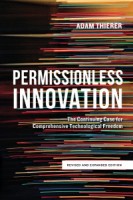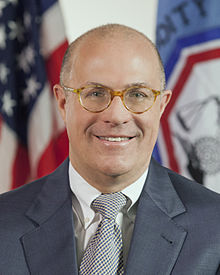Policy incentives matter and have a profound affect on the innovative capacity of a nation. If policymakers erect more obstacles to innovation, it will encourage entrepreneurs to look elsewhere when considering the most hospitable place to undertake their innovative activities. This is “global innovation arbitrage,” a topic we’ve discussed many times here in the past. I’ve defined it as, “the idea that innovators can, and will with increasingly regularity, move to those jurisdictions that provide a legal and regulatory environment more hospitable to entrepreneurial activity.” We see innovation arbitrage happening in high-tech fields as far-ranging as drones, driverless cars, and genetics,among others.
US policymakers might want to consider this danger before the nation loses its competitive advantage in various high-tech fields. Today’s most pressing example arrives in the form of potentially burdensome new export control regulations. In late 2018, the US Department of Commerce’s Bureau of Industry and Security announced a “Review of Controls for Certain Emerging Technologies,” which launched an inquiry about whether to greatly expand the list of technologies that would be subjected to America’s complex export control regulations. Most of the long list of technologies under consideration (such as artificial intelligence, robotics, 3D printing, and advanced computing technologies) were “dual-use” in nature, meaning that they have many peaceful applications.
Continue reading →
 Just three days ago I penned another installment in my ongoing series about the growing phenomenon of “global innovation arbitrage” — or the idea that “innovators can, and increasingly will, move to those countries and continents that provide a legal and regulatory environment more hospitable to entrepreneurial activity.” And now it’s already time for another entry in the series!
Just three days ago I penned another installment in my ongoing series about the growing phenomenon of “global innovation arbitrage” — or the idea that “innovators can, and increasingly will, move to those countries and continents that provide a legal and regulatory environment more hospitable to entrepreneurial activity.” And now it’s already time for another entry in the series!
My previous column focused on driverless car innovation moving overseas, and earlier installments discussed genetic testing, drones, and the sharing economy. Now another drone-related example has come to my attention, this time from New Zealand. According to the New Zealand Herald:
Aerial pizza delivery may sound futuristic but Domino’s has been given the green light to test New Zealand pizza delivery via drones. The fast food chain has partnered with drone business Flirtey to launch the first commercial drone delivery service in the world, starting later this year.
Importantly, according to the story, “If it is successful the company plans to extend the delivery method to six other markets – Australia, Belgium, France, The Netherlands, Japan and Germany.” That’s right, America is not on the list. In other words, a popular American pizza delivery chain is looking overseas to find the freedom to experiment with new delivery methods. And the reason they are doing so is because of the seemingly endless bureaucratic foot-dragging by federal regulators at the FAA. Continue reading →
In previous essays here I have discussed the rise of “global innovation arbitrage” for genetic testing, drones, and the sharing economy. I argued that: “Capital moves like quicksilver around the globe today as investors and entrepreneurs look for more hospitable tax and regulatory environments. The same is increasingly true for innovation. Innovators can, and increasingly will, move to those countries and continents that provide a legal and regulatory environment more hospitable to entrepreneurial activity.” I’ve been working on a longer paper about this with Samuel Hammond, and in doing research on the issue, we keep finding interesting examples of this phenomenon.
The latest example comes from a terrific new essay (“Humans: Unsafe at Any Speed“) about driverless car technology by Wall Street Journal technology columnist L. Gordon Crovitz. He cites some important recent efforts by Ford and Google and he notes that they and other innovators will need to be given more flexible regulatory treatment if we want these life-saving technologies on the road as soon as possible. “The prospect of mass-producing cars without steering wheels or pedals means U.S. regulators will either allow these innovations on American roads or cede to Europe and Asia the testing grounds for self-driving technologies,” Crovitz observes. “By investing in autonomous vehicles, Ford and Google are presuming regulators will have to allow the new technologies, which are developing faster even than optimists imagined when Google started working on self-driving cars in 2009.” Continue reading →
Earlier this week I posted an essay entitled, “Global Innovation Arbitrage: Commercial Drones & Sharing Economy Edition,” in which I noted how:
Capital moves like quicksilver around the globe today as investors and entrepreneurs look for more hospitable tax and regulatory environments. The same is increasingly true for innovation. Innovators can, and increasingly will, move to those countries and continents that provide a legal and regulatory environment more hospitable to entrepreneurial activity.
That essay focused on how actions by U.S. policymakers and regulatory agencies threatened to disincentivize homegrown innovation in the commercial drone and sharing economy sectors. But there are many other troubling examples of how America risks losing its competitive advantage in sectors where we should be global leaders as innovators looks offshore. We can think of this as “global innovation arbitrage,” as venture capitalist Marc Andreessen has aptly explained:
Think of it as a sort of “global arbitrage” around permissionless innovation — the freedom to create new technologies without having to ask the powers that be for their blessing. Entrepreneurs can take advantage of the difference between opportunities in different regions, where innovation in a particular domain of interest may be restricted in one region, allowed and encouraged in another, or completely legal in still another.
One of the more vivid recent examples of global innovation arbitrage involves the well-known example of 23andMe, which sells mail-order DNA-testing kits to allow people to learn more about their genetic history and predisposition to various diseases. Continue reading →
Capital moves like quicksilver around the globe today as investors and entrepreneurs look for more hospitable tax and regulatory environments. The same is increasingly true for innovation. Innovators can, and increasingly will, move to those countries and continents that provide a legal and regulatory environment more hospitable to entrepreneurial activity. I was reminded of that fact today while reading two different reports about commercial drones and the sharing economy and the global competition to attract investment on both fronts. First, on commercial drone policy, a new Wall Street Journal article notes that:
Amazon.com Inc., which recently began testing delivery drones in the U.K., is warning American officials it plans to move even more of its drone research abroad if it doesn’t get permission to test-fly in the U.S. soon. The statement is the latest sign that the burgeoning drone industry is shifting overseas in response to the Federal Aviation Administration’s cautious approach to regulating unmanned aircraft.
According to the Journal reporters, Amazon has sent a letter to the FAA warning that, “Without the ability to test outdoors in the United States soon, we will have no choice but to divert even more of our [drone] research and development resources abroad.” And another report in the U.K. Telegraph notes that other countries are ready and willing to open their skies to the same innovation that the FAA is thwarting in America. Both the UK and Australia have been more welcoming to drone innovators recently. Here’s a report from an Australian newspaper about Google drone services testing there. (For more details, see this excellent piece by Alan McQuinn, a research assistant with the Information Technology and Innovation Foundation: “Commercial Drone Companies Fly Away from FAA Regulations, Go Abroad.”) None of this should be a surprise, as I’ve noted in recent essays and filings. With the FAA adopting such a highly precautionary regulatory approach, innovation has been actively disincentivized. America runs the risk of driving still more private drone innovation offshore in coming months since all signs are that the FAA intends to drag its feet on this front as long as it can, even though Congress has told to agency to take steps to integrate these technologies into national airspace. Continue reading →
The future of emerging technology policy will be influenced increasingly by the interplay of three interrelated trends: “innovation arbitrage,” “technological civil disobedience,” and “spontaneous private deregulation.” Those terms can be briefly defined as follows:
- “Innovation arbitrage” refers to the idea that innovators can, and will with increasingly regularity, move to those jurisdictions that provide a legal and regulatory environment more hospitable to entrepreneurial activity. Just as capital now fluidly moves around the globe seeking out more friendly regulatory treatment, the same is increasingly true for innovations. And this will also play out domestically as innovators seek to play state and local governments off each other in search of some sort of competitive advantage.
- “Technological civil disobedience” represents the refusal of innovators (individuals, groups, or even corporations) or consumers to obey technology-specific laws or regulations because they find them offensive, confusing, time-consuming, expensive, or perhaps just annoying and irrelevant. New technological devices and platforms are making it easier than ever for the public to openly defy (or perhaps just ignore) rules that limit their freedom to create or use modern technologies.
- “Spontaneous private deregulation” can be thought of as de facto rather than the de jure elimination of traditional laws and regulations owing to a combination of rapid technological change as well the potential threat of innovation arbitrage and technological civil disobedience. In other words, many laws and regulations aren’t being formally removed from the books, but they are being made largely irrelevant by some combination of those factors. “Benign or otherwise, spontaneous deregulation is happening increasingly rapidly and in ever more industries,” noted Benjamin Edelman and Damien Geradin in a Harvard Business Review article on the phenomenon.[1]
I have previously documented examples of these trends in action for technology sectors as varied as drones, driverless cars, genetic testing, Bitcoin, and the sharing economy. (For example, on the theme of global innovation arbitrage, see all these various essays. And on the growth of technological civil disobedience, see, “DOT’s Driverless Cars Guidance: Will ‘Agency Threats’ Rule the Future?” and “Quick Thoughts on FAA’s Proposed Drone Registration System.” I also discuss some of these issues in the second edition of my Permissionless Innovation book.)
In this essay, I want to briefly highlight how, over the course of just the past month, a single company has offered us a powerful example of how both global innovation arbitrage and technological civil disobedience—or at least the threat thereof—might become a more prevalent feature of discussions about the governance of emerging technologies. And, in the process, that could lead to at least the partial spontaneous deregulation of certain sectors or technologies. Finally, I will discuss how this might affect technological governance more generally and accelerate the movement toward so-called “soft law” governance mechanisms as an alternative to traditional regulatory approaches. Continue reading →
 I am pleased to announce the release of the second edition of my book, Permissionless Innovation: The Continuing Case for Comprehensive Technological Freedom. As with the first edition, the book represents a short manifesto that condenses — and attempts to make more accessible — arguments that I have developed in various law review articles, working papers, and blog posts over the past few years. The book attempts to accomplish two major goals.
I am pleased to announce the release of the second edition of my book, Permissionless Innovation: The Continuing Case for Comprehensive Technological Freedom. As with the first edition, the book represents a short manifesto that condenses — and attempts to make more accessible — arguments that I have developed in various law review articles, working papers, and blog posts over the past few years. The book attempts to accomplish two major goals.
First, I attempt to show how the central fault line in almost all modern technology policy debates revolves around “the permission question,” which asks: Must the creators of new technologies seek the blessing of public officials before they develop and deploy their innovations? How that question is answered depends on the disposition one adopts toward new inventions. Two conflicting attitudes are evident.
One disposition is known as the “precautionary principle.” Generally speaking, it refers to the belief that new innovations should be curtailed or disallowed until their developers can prove that they will not cause any harms to individuals, groups, specific entities, cultural norms, or various existing laws, norms, or traditions.
The other vision can be labeled “permissionless innovation.” It refers to the notion that experimentation with new technologies and business models should generally be permitted by default. Unless a compelling case can be made that a new invention will bring serious harm to society, innovation should be allowed to continue unabated and problems, if they develop at all, can be addressed later.
I argue that we are witnessing a grand clash of visions between these two mindsets today in almost all major technology policy discussions today. Continue reading →
 U.S. Commodity Futures Trading Commission (CFTC) Commissioner J. Christopher Giancarlo delivered an amazing address this week before the Depository Trust & Clearing Corporation 2016 Blockchain Symposium. The title of his speech was “Regulators and the Blockchain: First, Do No Harm,” and it will go down as the definitive early statement about how policymakers can apply a principled, innovation-enhancing policy paradigm to distributed ledger technology (DLT) or “blockchain” applications.
U.S. Commodity Futures Trading Commission (CFTC) Commissioner J. Christopher Giancarlo delivered an amazing address this week before the Depository Trust & Clearing Corporation 2016 Blockchain Symposium. The title of his speech was “Regulators and the Blockchain: First, Do No Harm,” and it will go down as the definitive early statement about how policymakers can apply a principled, innovation-enhancing policy paradigm to distributed ledger technology (DLT) or “blockchain” applications.
“The potential applications of this technology are being widely imagined and explored in ways that will benefit market participants, consumers and governments alike,” Giancarlo noted in his address. But in order for that to happen, he said, we have to get policy right. “It is time again to remind regulators to ‘do no harm,'” he argued, and he continued on to note that
The United States’ global leadership in technological innovation of the Internet was built hand-in-hand with its enlightened “do no harm” regulatory framework. Yet, when the Internet developed in the mid-1990s, none of us could have imagined its capabilities that we take for granted today. Fortunately, policymakers had the foresight to create a regulatory environment that served as a catalyst rather than a choke point for innovation. Thanks to their forethought and restraint, Internet-based applications have revolutionized nearly every aspect of human life, created millions of jobs and increased productivity and consumer choice. Regulators must show that same forethought and restraint now [for the blockchain].
What Giancarlo is referring to is the approach that the U.S. government adopted toward the Internet and digital networks in the mid-1990s. You can think of this vision as “permissionless innovation.” As I explain in my recent book of the same title, permissionless innovation refers to the notion that we should generally be free to experiment and learn new and better ways of doing things through ongoing trial-and-error. Continue reading →
 Last Wednesday, it was my great pleasure to testify at a Senate Commerce Committee hearing entitled, “The Connected World: Examining the Internet of Things.” The hearing focused “on how devices… will be made smarter and more dynamic through Internet technologies. Government agencies like the Federal Trade Commission, however, are already considering possible changes to the law that could have the unintended consequence of slowing innovation.”
Last Wednesday, it was my great pleasure to testify at a Senate Commerce Committee hearing entitled, “The Connected World: Examining the Internet of Things.” The hearing focused “on how devices… will be made smarter and more dynamic through Internet technologies. Government agencies like the Federal Trade Commission, however, are already considering possible changes to the law that could have the unintended consequence of slowing innovation.”
But the session went well beyond the Internet of Things and became a much more wide-ranging discussion about how America can maintain its global leadership for the next-generation of Internet-enabled, data-driven innovation. On both sides of the aisle at last week’s hearing, one Senator after another made impassioned remarks about the enormous innovation opportunities that were out there. While doing so, they highlighted not just the opportunities emanating out of the IoT and wearable device space, but also many other areas, such as connected cars, commercial drones, and next-generation spectrum.
I was impressed by the energy and nonpartisan vision that the Senators brought to these issues, but I wanted to single out the passionate statement that Sen. Cory Booker (D-NJ) delivered when it came his turn to speak because he very eloquently articulated what’s at stake in the battle for global innovation supremacy in the modern economy. (Sen. Booker’s remarks were not published, but you can watch them starting at the 1:34:00 mark of the hearing video.) Continue reading →





 The Technology Liberation Front is the tech policy blog dedicated to keeping politicians' hands off the 'net and everything else related to technology.
The Technology Liberation Front is the tech policy blog dedicated to keeping politicians' hands off the 'net and everything else related to technology.